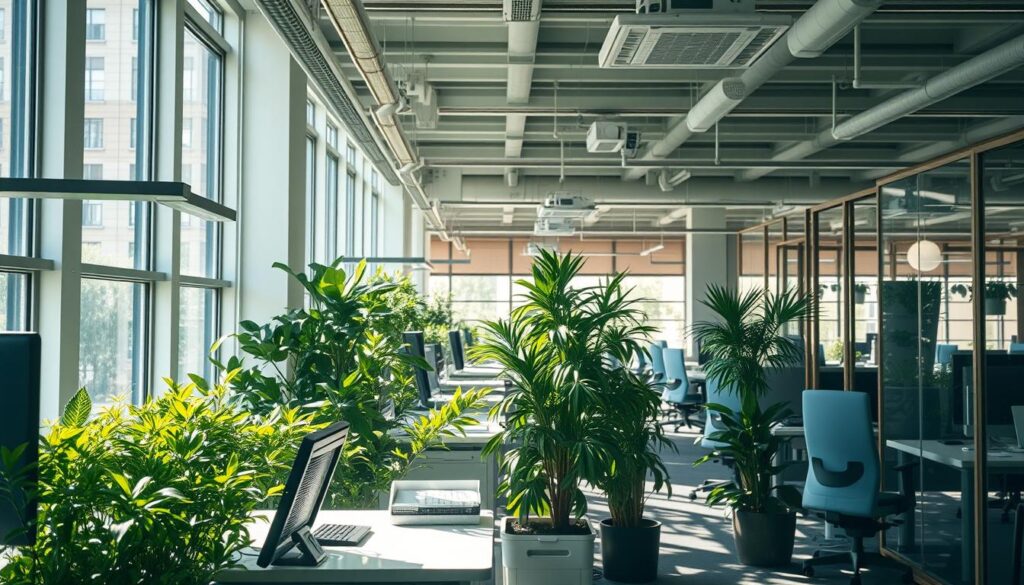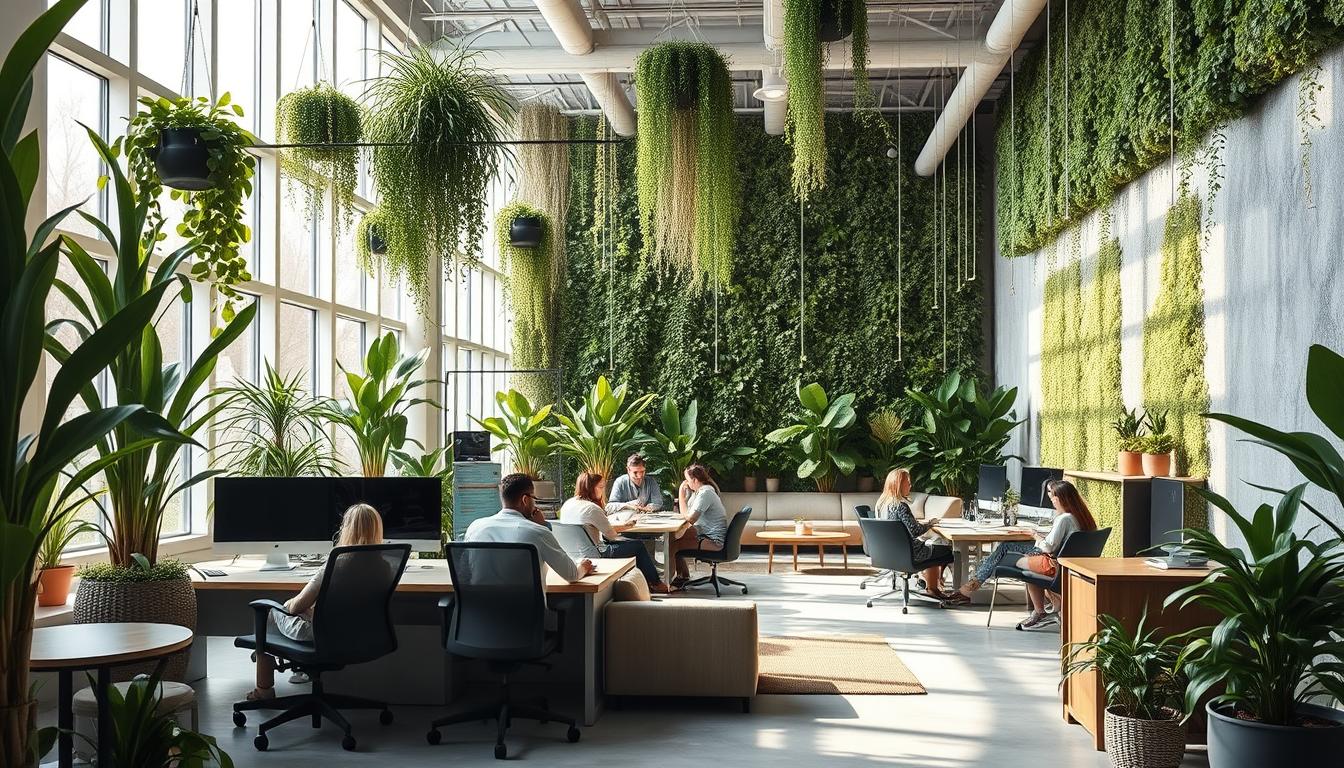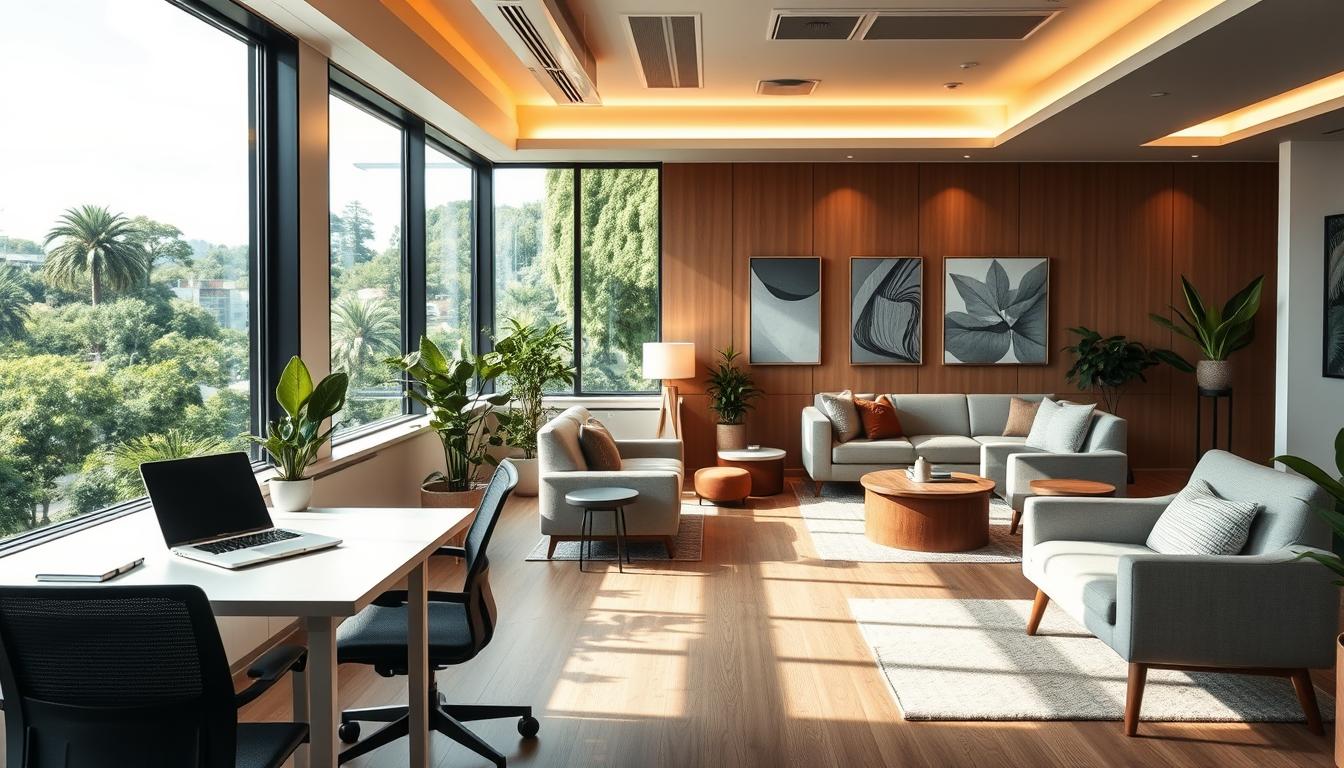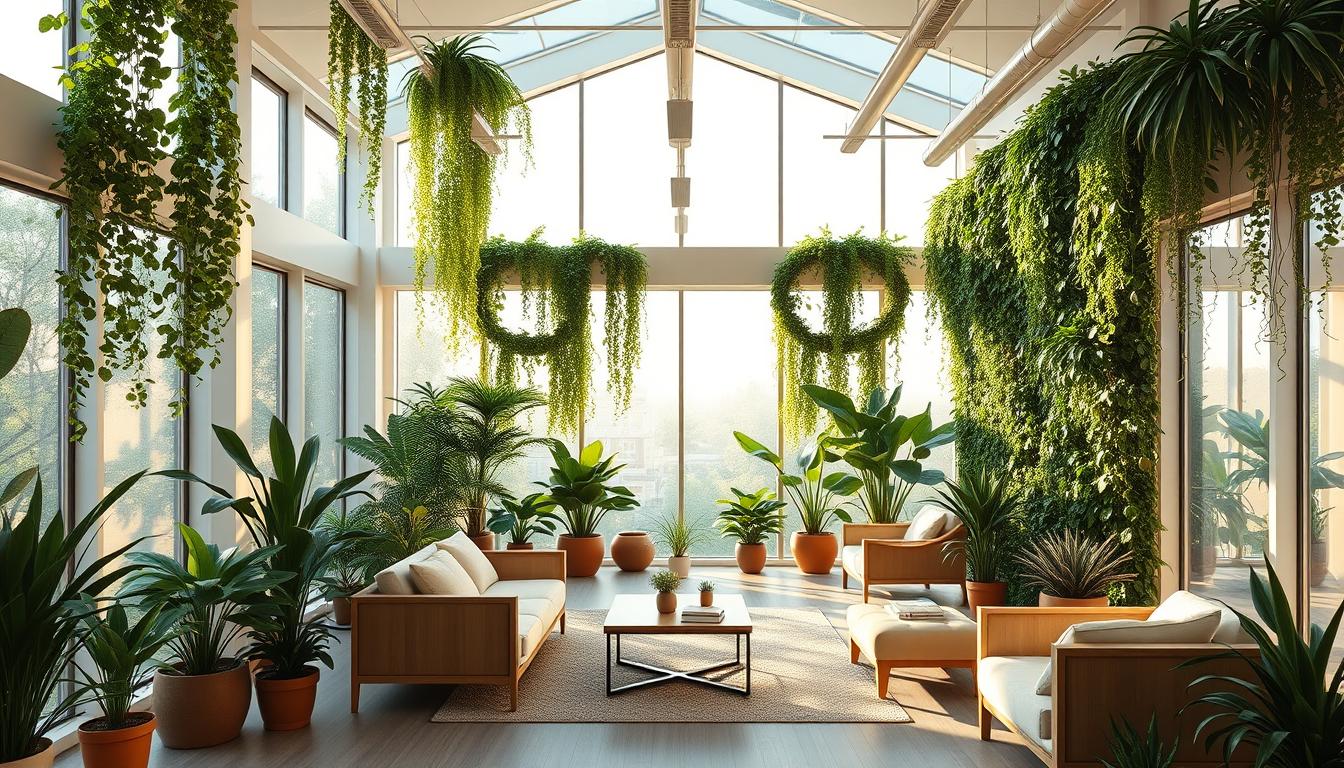Companies are focusing more on sustainability and using microclimate sensing in green offices. This means using high-tech sensors to check and control the environment right where employees work. It helps make employees more comfortable and saves energy too.
By looking into how these sensors affect health and work, businesses can make offices that are great to work in and perform well. Moving to smart office environments is key to making employees happy and building a strong work culture.
The Importance of Microclimate in the Workplace
Microclimates are very important in the workplace setting. They create unique climates that affect indoor conditions and employee health. Knowing about things like building materials and plants helps make work spaces more comfortable and productive.
Understanding Microclimates
Microclimates form from both natural and man-made elements. The addition of plants and water features can cool an area and add moisture. This can change the way we feel in a space. Cities like Los Angeles show how knowing about microclimates can reduce heat in urban areas. By paying attention to these factors, businesses can make their offices more comfy for everyone.
Impact of Microclimates on Employee Well-being
Microclimates really do affect how happy and productive employees are. Changes in temperature and moisture can influence creativity and job happiness. Using green design helps improve the air and temperature at work. This leads to healthier employees who stay with the company longer and are more involved in their jobs. So, it’s important for workplace design to consider microclimates.

Microclimates and Indoor Air Quality
Indoor air quality is key to worker health, shaped by environmental factors. Knowing these factors helps make workspaces healthier. Microclimates can make indoor air much more polluted than outside. So, it’s critical to control temperature, humidity, and airflow to better air quality and health.
How Environmental Factors Affect Air Quality
Humidity, temperature, and airflow greatly affect indoor air quality. Too much humidity can lead to mold. Too much heat can make it hard to focus. Good airflow can lower pollutants, making work areas better. Companies like Autodesk use advanced filters and plants to tackle these problems. Keeping an eye on these conditions is key to a healthy indoor space.
The Role of Microclimate Sensing in Air Quality Management
Microclimate sensing tech gives firms tools to boost air quality. It offers instant data, letting companies tweak their systems. This tech targets pollution sources for cleaner air. It reduces health issues and boosts worker well-being and productivity. Using this tech means a proactive way to keep air clean, important for a healthy office.
Microclimate Sensing in Green Offices
Offices are focusing more on sustainability, using microclimate sensors. These sensors check temperature, humidity, and CO2 levels. By doing so, they keep the office comfy for everyone.
Utilizing Sensors for Better Climate Control
Sensors help improve climate control at work, meaning conditions can be just right. They take readings in real-time. So, the workspace feels good, which helps everyone do their best.
They’re placed thoughtfully to make indoor spaces better. This helps save energy and boosts work productivity. Quick adjustments to changes show how advanced office tech has become.
Integration with HVAC Systems for Efficiency
Linking sensors with HVAC systems makes offices smarter and more energy-efficient. This way, heating and cooling only turn on when needed. It cuts down on energy use.
This smart move helps companies be more sustainable and saves money. Using this tech means designing greener, healthier offices for everyone.
Creating Comfortable Workspaces with Microclimate Data
Microclimate data helps make workspaces comfortable. It allows for precise changes in temperature and humidity. This creates a healthy environment that employees enjoy. It also helps them do their best work.
Optimizing Temperature and Humidity Levels
Keeping the right temperature boosts work output. A cozy 72°F is good for this. Being in charge of humidity is also key. Too much makes you uncomfortable, too little can affect your skin and breathing. A nice balance makes the office feel better.
Enhancing Lighting Variability for Employee Comfort
Lighting plays a big role in how we feel at work. Good natural light keeps us happy and focused. By using different lights for various tasks, everyone stays comfortable. Adjustable lights not only help us work better but also make the office a nicer place to be.
The Role of Natural Light in Green Office Design
Natural light is very important in today’s office design. It greatly affects how well employees work and feel. Access to natural light can make productivity up by 20%. This shows how crucial it is to have enough natural light in green buildings. By using the sunlight well, companies can make their employees work better.
Benefits of Natural Light on Productivity
Natural light does more than just make things look nice. It has big benefits such as:
- Making employees feel happier and less stressed.
- Helping employees concentrate better on their work.
- Reducing tiredness, so energy lasts longer in the day.
When offices use natural light in their design, they create a healthier workforce. This fits with the idea of green architecture.
Strategies for Maximizing Natural Light
There are ways to get the most out of natural light in offices:
- Use an open office layout to let light move freely.
- Have gardens around windows to add beauty and light.
- Put in skylights to bring daylight to areas without windows.
Choosing these design features can make an office more productive. Putting a focus on natural light improves the work life. It also shows a company’s dedication to green architecture.
Acoustic Microclimates: Elevating Workplace Comfort
Creating a good work environment is about more than comfy chairs and enough light. How things sound at work really shapes how well employees do. Acoustic microclimates make a big difference in how we connect with our space, affecting our focus and work speed. Studies show that offices with controlled sound improve productivity a lot.
The Effect of Sound on Employee Performance
Noise at work can really change how well employees perform. Too much noise makes it hard to focus and messes with work flow. Research finds that the right sound settings can boost work output by up to 25%. This shows how crucial good sound control is.
Designing Spaces for Optimal Acoustic Management
Making a workplace sound right is key to a good work environment. Using materials that soak up sound and making separate zones helps reduce distractions. Important parts of better workplace sound include:
- Using sound-absorbing panels in open spaces
- Setting up quiet zones for focus
- Adding soft furniture to reduce noise
- Planning office layouts to keep noise down
By focusing on these areas, companies can create a nicer work environment. They improve comfort and help employees work better, thanks to smart sound control.
Adapting Office Spaces with Microclimate Sensing Technology
Modern offices are changing to meet employee needs better. Microclimate technology is key to this change. It helps create work environments that match what employees need. This tech makes offices more flexible and supports a workplace that cares about comfort and working together.
Flexibility for Individual Preferences
Microclimate sensing tech lets companies make workspaces that fit different employee needs. It adjusts things like temperature, humidity, and air cleanliness on the spot. This makes sure everyone is comfortable and can focus. Being comfortable makes people happier and more productive, which is good for the whole company.
Creating Multi-functional Work Areas
Offices are using movable walls and adaptable furniture to make spaces more flexible. This means one area can be quiet one moment and a place for team work the next. People can choose the best spot for their work. This helps with creativity and teamwork and lets everyone work in a way that suits them best.
The Impact of Green Spaces on Employee Health
Bringing green spaces into offices greatly improves worker health and happiness. Studies show that plants in the workplace boost morale and make jobs more satisfying. They create a fresh environment that supports well-being.
Benefits of Incorporating Vegetation
Adding plants and green areas at work has many benefits:
- It lowers stress, which is good for mental health.
- It improves air quality, which helps everyone stay healthy.
- It makes people more social, building a stronger community.
- It boosts creativity and work performance by making spaces more engaging.
Studies Linking Green Spaces to Employee Satisfaction
Many studies link green spaces with happier workers. One key discovery is that people who spend time around plants are 23% more satisfied with their jobs. This shows how important plants are for a positive work environment and a healthy work culture.
Strategies for Implementing Microclimate Sensing
To start using microclimate sensing, plan carefully to get the most from monitoring your office environment. Begin by putting sensors in the right spots. This is to catch all sorts of environmental changes. It’s crucial to keep track of these conditions steadily over time.
Steps for Sensor Deployment in Offices
Setting up sensors involves a few key steps:
- Check the office layout to find the best places for sensors.
- Pick which sensors you’ll need, based on what you want to monitor.
- Place sensors in areas where the environment affects workers the most.
- Test the sensors to make sure they work well and cover the right areas.
Data Monitoring and Analysis Techniques
After installing the sensors, it’s crucial to monitor the data correctly. This means using different methods to analyze the data. Companies should do the following:
- Monitor the data in real-time to notice changes right away.
- Analyze data over a long period to spot trends and patterns.
- Make changes to office environments based on what the data tells you.
Conclusion
Integrating microclimate sensing in green offices is key for better comfort and work productivity. It allows companies to create places where workers feel good, thanks to controlled temperature, humidity, and light. This focus not only makes the office more comfortable but also keeps everyone healthier.
Looking ahead, eco-friendly workplaces will use advanced tech for real-time data and changes. Such trends make it easier for businesses to be green and efficient. With smart microclimate strategies, offices can be places of creativity and care for the planet.
In the end, focusing on microclimate sensing will make workspaces healthier and more lively. It meets employee needs and helps create a greener, sustainable future in office design.



